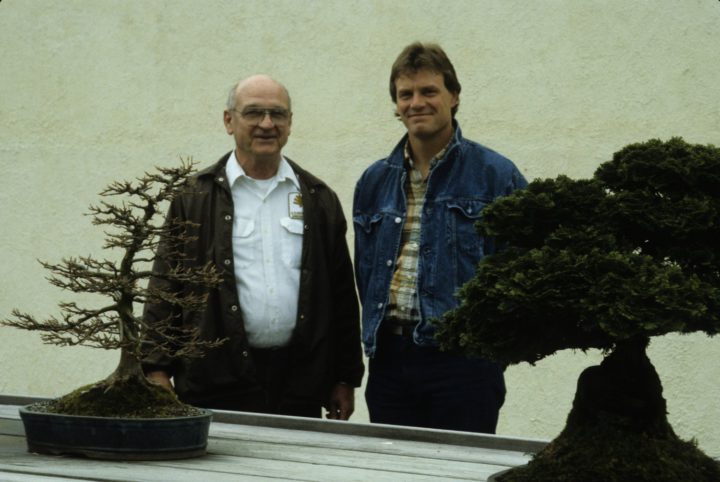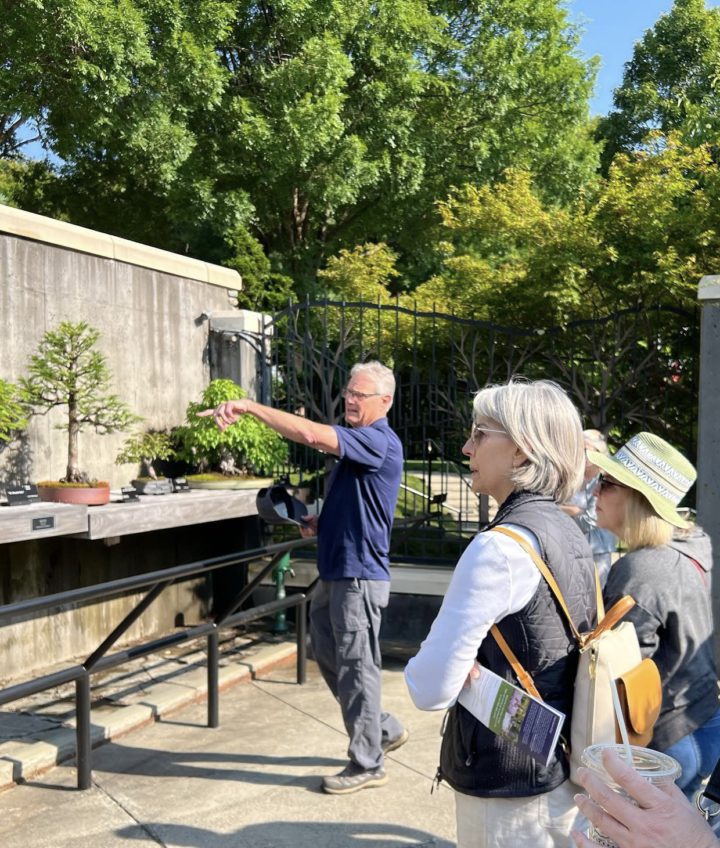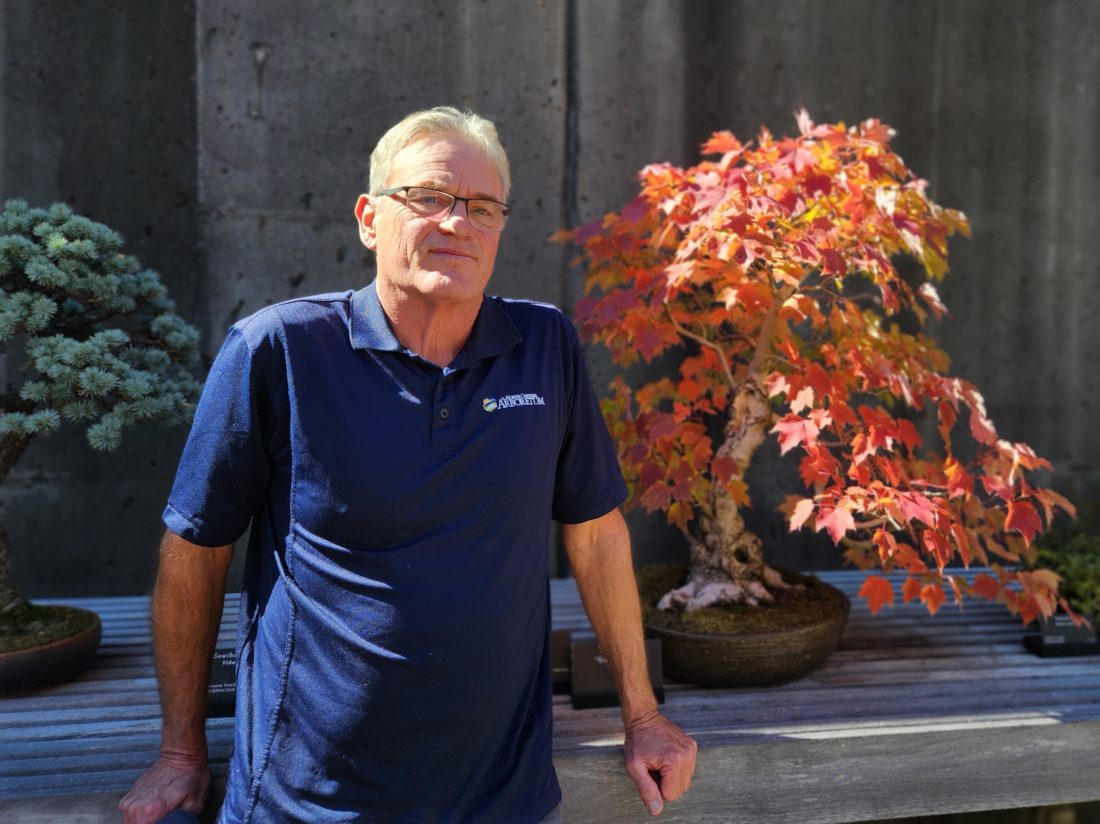The origins of bonsai’s ascent in Asheville can be traced to a timely gift and a courageous decision.
In 1992, George Staples of Butner donated his wife’s bonsai collection to The N.C. Arboretum, which was just a single building surrounded by forest at the time. Cora Staples was in poor health, and her small potted trees were in equally bad shape.
As generous as the gift was, it left the arboretum in a bit of a bind. It had no one on staff trained to care for bonsai. Who would look after them? The conventional move in such a situation is to hire a professional with years of experience. Instead, John Creech, an influential board member who had co-founded the arboretum and served as its interim director from 1986-87, lobbied for Arthur Joura, at the time an assistant to the nursery manager who knew nothing about bonsai.
As strange as the choice seemed, it had a precedent. After Japan donated 53 bonsai to the U.S. National Arboretum in Washington to commemorate the U.S. Bicentennial in 1976, Creech, the arboretum’s director at the time, hired Bob Drechsler to care for them. Despite starting with no bonsai experience, Drechsler went on to serve as curator of the National Bonsai & Penjing Museum, which houses the premier bonsai collection in the country, for more than 20 years and was continually applauded for his work.
“Bonsai came to me uninvited,” says Joura, who has now held the title of bonsai curator at The N.C. Arboretum for over 30 years. “Sometimes your best move is to go with the flow and try to work with the tide and not against it.”
To get Joura up to speed, Creech arranged for him to study with Drechsler in Washington in April 1993, an experience that opened Joura’s eyes. “I saw what bonsai were supposed to look like,” he says, “and then I went home and saw what we had and could see the difference.”
An even more formative educational experience occurred the following year when Yuji Yoshimura, the son of a Japanese samurai and founder of the Bonsai Society of Greater New York, invited Joura to apprentice with him at his studio in Briarcliff Manor, N.Y. Joura was Yoshimura’s last student before the influential bonsai master died in 1997.
“This man had the biggest impact on my bonsai thinking,” says Joura. “He encouraged me to think for myself and question everything. At the end, he said to me, ‘Even the things I tell you, don’t believe all of it.’”
There is no teahouse
American bonsai professionals inevitably get asked if they have ever studied in Japan. Having trained with Saburo Kato for a month in 1998, Joura can say yes. But while he respected Kato’s extensive knowledge, he came away from the experience ready to do bonsai his way. “The overwhelming feeling I came back with was, ‘That was amazing, but it’s never going to be like that here. That culture is not our culture.’”
The only link between the bonsai Joura cultivates at The N.C. Arboretum and the bonsai found in Japan is the word itself. When the arboretum’s Bonsai Exhibition Garden opened in 2005, Joura made sure that it didn’t look like a Japanese bonsai garden but a Southern Appalachian one. Most American bonsai collections mimic Asian ones by displaying the same species of trees found in the region: Japanese white pines and Chinese elms are some of the most popular. But in alignment with the arboretum’s emphasis on promoting native plants, Joura features local trees such as the American hornbeam and eastern white pine.
“It goes beyond the fact that we use native plants,” he says. “It has to do with disassociating from the commonly held perception of what bonsai is supposed to be. For most people, it’s The Karate Kid and the whole Japanese mystique. We try to not have anything to do with that, which is really hard because everybody has that association. It’s so reflexive that it’s very difficult to swim against it.”
Joura recalls overhearing someone say, “Look at this beautiful teahouse,” as they walked through the Bonsai Exhibition Garden’s post-and-beam pavilion.
“There’s nothing ‘teahouse’ about it,” he says. “They came in with such a clear idea about what it’s supposed to be that they saw what they felt like they were supposed to see.”
‘Through emotion rather than intellect’
Joura’s iconoclastic take on the pursuit helped put Asheville’s bonsai community on the map, but it didn’t attain the lofty heights it currently enjoys until Felix Laughlin moved to Asheville in 2010.

As a young corporate tax lawyer in New York City, Laughlin was working around the clock in 1972 when his wife, Betty Gayle, gave him several bonsai to help take his mind off work. “We were in this claustrophobic little apartment in Manhattan, no balcony or anything,” he says. “So, we put the trees, which were deciduous, in the refrigerator to make them go into dormancy. When we opened the door, we could see fall.”
Laughlin learned the basics from Frank Okamura, the Brooklyn Botanic Gardens’ bonsai specialist, before studying with John Naka, a bonsai master and founder of the California Bonsai Society whose influence on American bonsai rivaled that of Yoshimura.
When Laughlin and Gayle moved to Washington, he brought his passion for bonsai with him. In 1982, he co-founded the National Bonsai Foundation, a nonprofit that supports the National Bonsai & Penjing Museum, and he served as president of the World Bonsai Friendship Federation from 2001-05.
Laughlin’s cultivated many bonsai plants himself, including a ponderosa pine he found in the Rocky Mountains on an excursion with Dan Robinson, a firefighter from Bremerton, Wash., whom he met at a bonsai convention in New York.
“He would go out for five days in the mountains and collect, then go back to the fire station and work for 24 or 48 hours. And while he was at the fire station, he’d work on the trees,” says Laughlin. “He had his own style. He wanted everything to be rough and natural as opposed to the very refined Japanese techniques where everything’s perfect.”
While Laughlin admits to keeping a notebook full of data about every bonsai he’s tended, Joura bristles at the idea of attaching any quantitative value, such as age or sales price, to bonsai.
“People have heard there are trees that are hundreds, even thousands, of years old, so that becomes what’s interesting to them,” Joura says. “I’d rather try to reach them through particular feelings, emotions and associations they have with trees; to connect with people through emotion rather than intellect.”
Breaking the rules
Joura previously studied art in New York City, and his extensive knowledge of the subject informs his view of bonsai. Traditionally, bonsai should have a front and a back, and the front is supposed to lean toward the viewer as if bowing. Joura happily ignores such rules.
“One of the things that I clash with bonsai traditionalists about is that they design bonsai as if they were two-dimensional, not three-dimensional, objects,” he says. “It’s all premised on the idea that this tree will be presented and seen from one direction only, and nobody even questions that. I’m trying to free it from being locked into some cliche, preconceived idea where everything has to fit the same mold, because that’s not how art works.”
Laughlin applauds Joura’s stance on this issue. “The Japanese have specific rules – nothing can go straight down, you can’t have a bar branch – and he violates all those rules because that’s not the way nature really is. That’s his whole raison d’etre.”
Most people enjoy Joura’s unique take on the art form. The few who don’t absolutely hate it.
Joura tells a story about a 16-year-old boy from Georgia who criticized nearly every aspect of the arboretum’s collection. A student of American bonsai master Ryan Neil, the boy told Joura the pot that he’d selected for one of his trees was wrong. He followed that up by asking Joura a question riddled with Japanese terminology.
Joura laughs at the memory. “Having raised children, I know the look of a 16-year-old who thinks, ‘I must be talking to the stupidest person on earth,’” he says. “That’s the look he gave me.”
On another occasion, a visiting bonsai purist harangued a volunteer about the branch of a particular red maple. Joura had allowed it to grow unusually long because it made the bonsai look like trees he’d actually observed in nature.
“The way [my bonsai] are constructed, it’s not based on what I was taught or what the books tell you to do,” he explains. “It’s based on what I’ve seen in my own experience and run through the filter of my knowledge of art. The object is to make something worth looking at, thought-provoking and meaningful.”
The bonsai purist couldn’t see beyond the rule he believed Joura had broken, calling the branch “way too long” and “wrong.”
How did Joura respond? He named the bonsai “Long Branch” and kept it the way it was.
‘An affront to the electronic age’
When Asheville’s Blue Ridge Bonsai Society started in the 1970s, it only had about 20 members. Laughlin joined its board of directors soon after moving to Asheville, and since that time, the nonprofit’s membership has ballooned to more than 100 members.
He’s had a similar impact on the Bonsai Exhibition Garden at the arboretum, where he’s served on the board of directors in the past. Thanks in part to his strong ties with the World Bonsai Friendship Federation, in 2012 the WBFF named the Bonsai Exhibition Garden a resource center, a distinction given to only one other collection in the U.S. at the time.
In June, Laughlin organized the exhibit “Bonsai as a Fine Art at the Blue Spiral 1. It featured 20 works borrowed from the arboretum, members of the Blue Ridge Bonsai Society and professional bonsai artists such as Bjorn Bjornholm and Daniel Coffey. The intention was to represent bonsai not as a niche horticultural pastime but as a fine art the same way it’s been done at the Tokyo Metropolitan Art Museum since 1934.

The exhibition wasn’t meant to replace the Carolina Bonsai Expo, the annual gathering Joura hosted at the arboretum every October for 24 years before COVID ended its run for good, but it did offer a similar experience for bonsai aficionados and professionals.
“Felix was the dynamo behind that show,” says Joura. “It wouldn’t have happened without him.”
Given their outsized roles in Asheville’s bonsai community, Joura and Laughlin see each other often. They recently went on an excursion together to the Great Smoky Mountains to look at trees.
For Joura, it was a rare trip away from his bonsai. When he first started working with them at the arboretum, he did all the trimming, wiring and watering himself. He now has a paid assistant and four volunteers, but he still remains tethered to his trees’ care. During his career at the arboretum, he’s never been able to enjoy a vacation that’s lasted more than a few days, and that’s fine with him. “This is work that I find personally meaningful and rewarding,” he says. “I do it not as a job but as an expression of my creative energy and desire to communicate with people.”
Joura has started chronicling the demands and rewards of tending to bonsai in The Curator’s Journal, a yearlong course offering an insider’s view of his work. As much as Joura wants to appeal to those who have no experience with bonsai, he’s also quick to warn them of its perils. “People might think they want to own one, but that’s only because they don’t understand what it takes to keep them,” he says. “You have to monitor it pretty much on a daily basis during the growing season.”
He observes that when aspiring bonsai owners find out what’s required of them it’s often enough to steer them in a different direction. “They don’t want to do it because it’s insane: ‘I have to wait 20 years for this to look like something? What if I want to go away for a couple of weeks?’ In the current culture, those kinds of things are unacceptable. You can’t take that long to get where you’re going. It’s an affront to the electronic age.”
Laughlin can relate to the all-encompassing nature of the pursuit. “For me, it’s more than a hobby. It’s a practice of life.”



Wonderful to learn more about bonsai in this area. I’ve seen the bonsai at the Arboretum and went to the Blue Spiral exhibit but didn’t really understand their significance and the evolution of bonsai knowledge and philosophy here in WNC. Great.
We love the NC Arboretum and especially enjoy immersing ourselves at least once a year in the miniature landscape worlds of the bonsai walk. Some thoughts: If the curators wish to separate the art of bonsai from Japanese culture, then don’t do bonsai at all. It’s marvelous to create a distinctive American style using native plants and rules of the natural rather than traditional, but bonsai, at heart is Japanese, whose forms arise from an ancient kingdom, a highly ordered society, and a relatively limited availability of land. From my perspective, a truly American style, or school of “bonsai,” would feature no miniaturization at all, and minimal maintenance. For example, many years ago I dug a head-high American beech from the mountainside of my wife’s family property and planted it on our 1/3 acre yard. I selected this beech out of dozens because of its size and the beautiful structure of its limbs. That beech is only trimmed to keep branches from hanging over our parking area, but its early form is still preserved. It is, simply, a natural work of art that’s now 30 feet high. A more accessible family relation to Japanese bonsai, is ikebana, or flower arranging, which I prefer to the life-long commitment required from a bonsai collection.